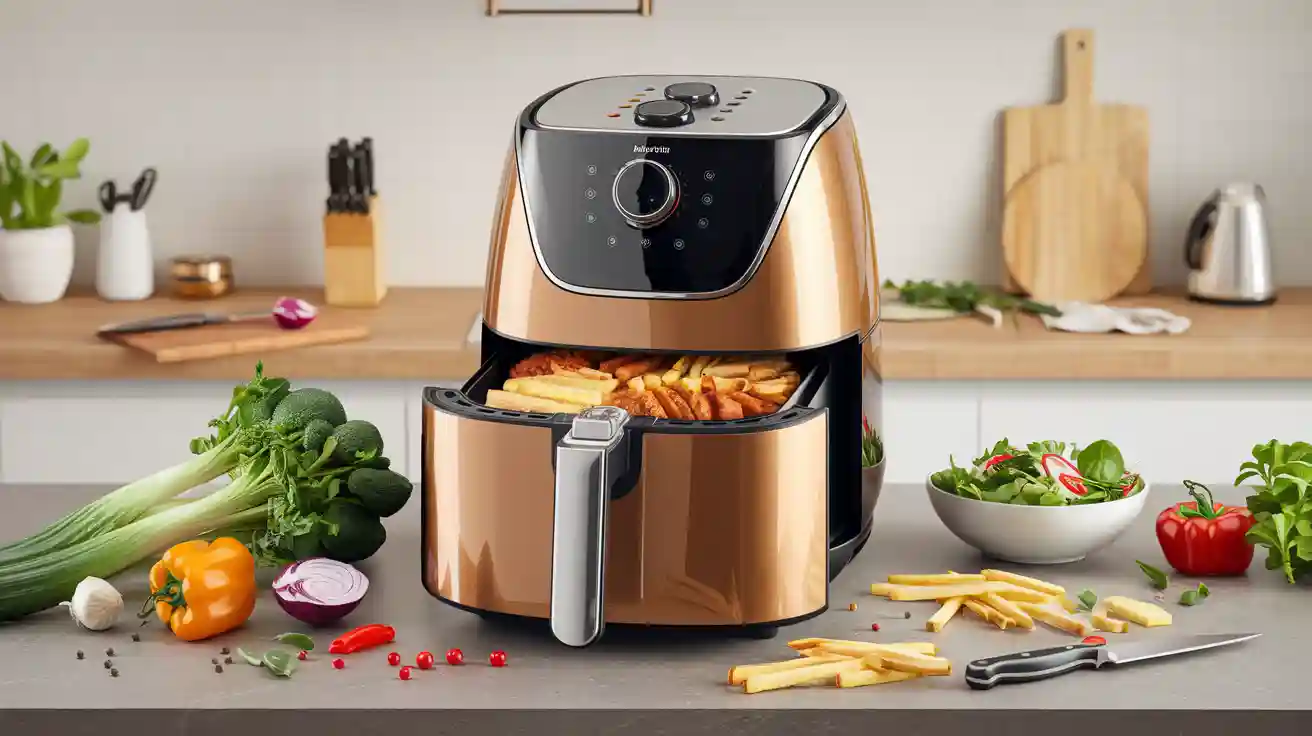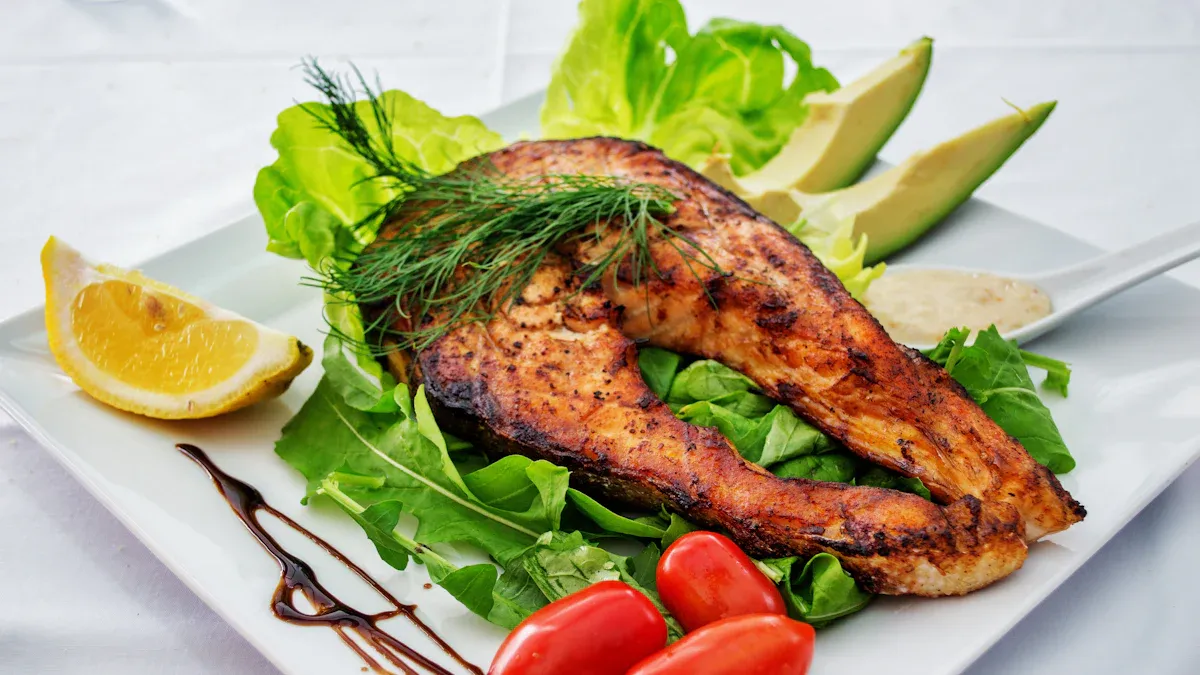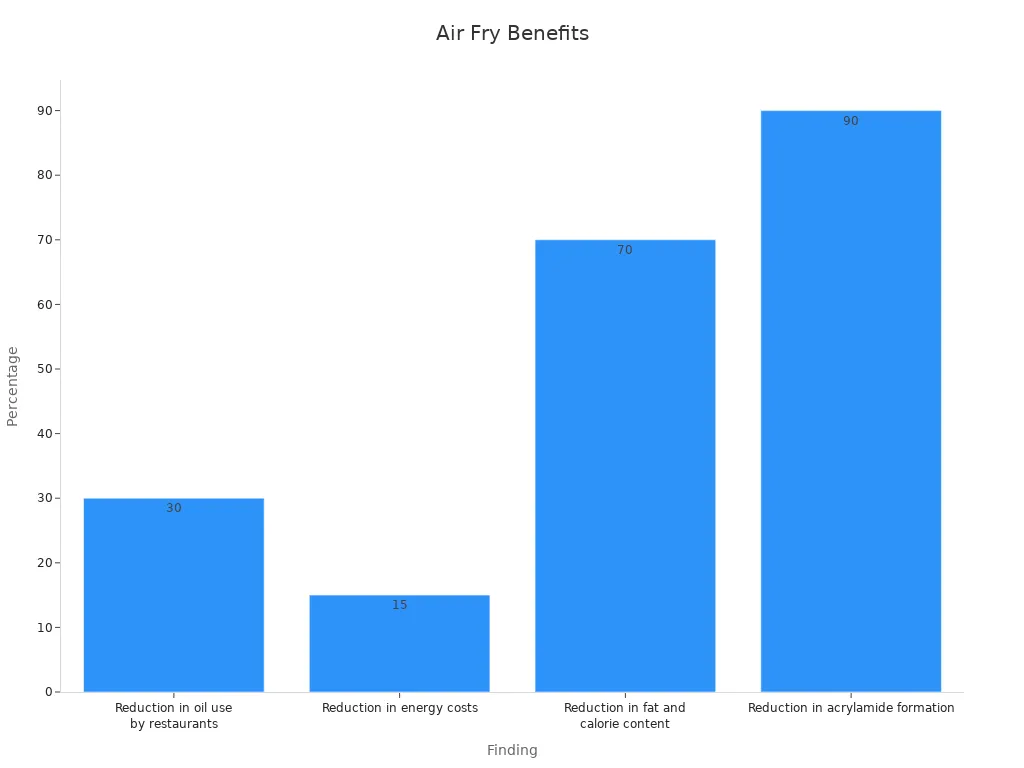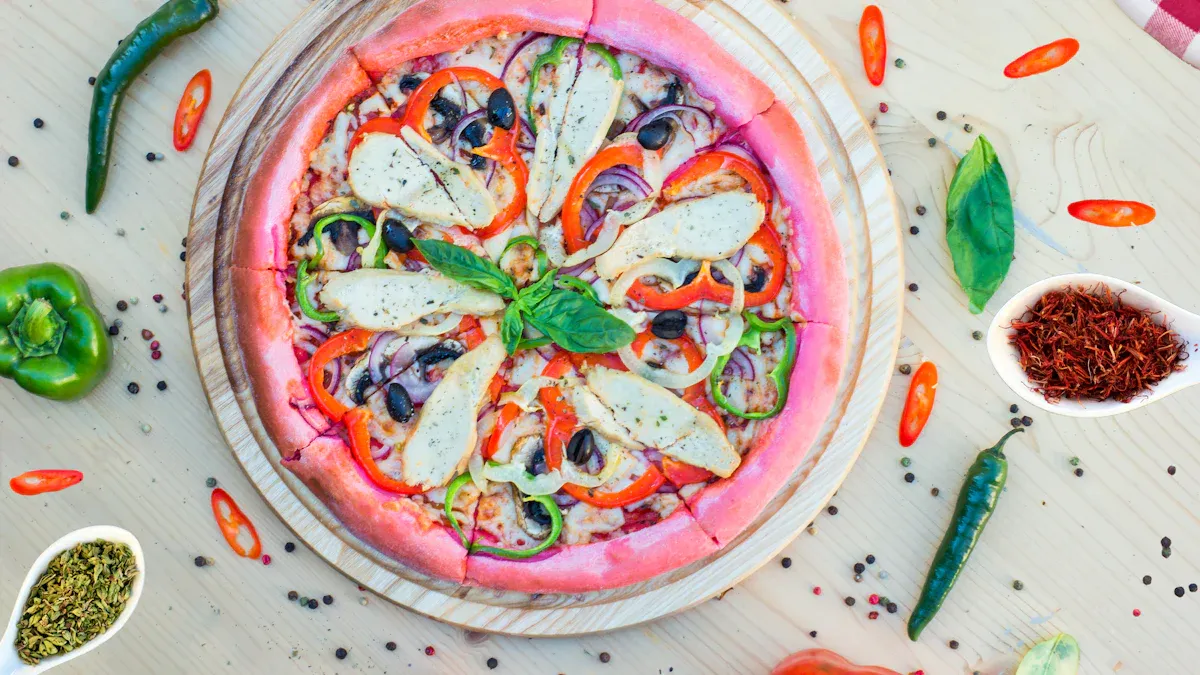
Imagine cooking your favorite fried foods with all the crispy results you love but without the guilt. That’s the magic of an air fryer. These devices have become a staple in nearly 60% of American homes, and it’s no surprise why. They use minimal oil, making meals lighter and better for your health. Plus, studies show air fryers reduce harmful chemicals found in traditional frying. With their growing popularity, air fryers are reshaping how we think about cooking healthier meals.
Key Takeaways
Air fryers need little oil, so meals are healthier. They still make food crispy and can cut calories by 70% to 80% compared to frying in oil.
These machines cook faster than regular ovens, saving time. For instance, frozen fries can turn crispy in just 12 minutes.
Air fryers can do many things like roast, bake, grill, and dry food. You can make lots of recipes with just one machine.
Newer models have features like exact temperature settings and smart controls. These make cooking simpler and quicker.
For the best results, don’t overcrowd the basket. Always spread food in one layer to cook it evenly.
Understanding Air Fryer Technology
What is an air fryer
If you’ve ever wondered how to enjoy crispy, golden-brown meals without the guilt of deep frying, an air fryer might just be your new best friend. At its core, an air fryer is a compact kitchen appliance designed to mimic the results of frying but with significantly less oil—or sometimes none at all. It uses a combination of heating elements and high-speed fans to circulate hot air around your food, creating that signature crunch you love.
Here’s a quick breakdown of what makes an air fryer tick:
Feature | Description |
|---|---|
Cooking Mechanism | |
Temperature Range | Typically between 180°F and 400°F, suitable for a variety of recipes. |
Energy Efficiency | Smaller size and faster cooking make it more energy-efficient than traditional ovens. |
Versatility | Perfect for crispy foods like fries and wings, but also great for roasting veggies or baking. |
Air fryers are compact, easy to use, and versatile, making them a staple in many kitchens. In fact, surveys show that 93.4% of people who own one rely on it regularly for meal prep. Whether you’re reheating leftovers or whipping up a fresh batch of chicken tenders, this gadget simplifies cooking while keeping it healthier.
Tip: For the best results, always arrange food in a single layer. This ensures even airflow and consistent cooking.
How air frying works
So, how does an air fryer transform raw ingredients into crispy perfection? It’s all about the magic of convection. When you turn on your air fryer, the heating element warms up, and the fan kicks in to circulate hot air rapidly around your food. This process creates a high-temperature environment that cooks food evenly and quickly.
Unlike traditional frying, which relies on submerging food in hot oil, air frying uses minimal oil—just enough to coat the surface. This not only reduces fat content but also eliminates the greasy texture often associated with fried foods.
Here’s why air frying stands out:
Healthier meals: You can achieve crispy textures with up to 80% less oil.
Faster cooking times: The rapid air circulation speeds up the cooking process.
Consistent results: The even heat distribution ensures no soggy or undercooked spots.
If you’re someone who loves fried foods but wants to cut back on calories, air frying is a game-changer. Plus, it’s incredibly versatile—you can roast, bake, and even grill with the same appliance.
The science of hot air circulation
The secret behind an air fryer’s efficiency lies in its ability to circulate hot air. This process, known as convection, is driven by temperature gradients that create density differences in the air. As the fan pushes the heated air around, it envelops your food, cooking it from all angles.
Here’s a closer look at how it works:
Aspect | Air Frying | Traditional Frying |
|---|---|---|
Heat Transfer Medium | Hot air | Hot oil |
Cooking Mechanism | Convection (circulating hot air) | Submersion in hot oil |
Oil Requirement | Minimal to none | Requires large amounts of oil |
Cooking Temperature | 140-165°C for Maillard reaction | 150-200°C for frying |
Efficiency | Consumes less energy, shorter cooking times | Less efficient, longer cooking times |
Texture | Crispy due to moisture removal | Crispy due to oil absorption and moisture loss |
Studies show that air frying not only reduces oil usage but also minimizes the formation of harmful compounds like acrylamide, which can occur during traditional frying. This makes it a safer and healthier option for you and your family.
Did you know? Air fryers can also help preserve the natural flavors and nutrients in your food, thanks to their shorter cooking times and lower temperatures.
By understanding the science behind hot air circulation, you can make the most of your air fryer and enjoy meals that are both delicious and nutritious.
Types of Air Fryers
When it comes to choosing the right air fryer for your kitchen, you’ll find a variety of options tailored to different cooking needs. Let’s explore the three main types of air fryers and what makes each one unique.
Standalone air fryers
Standalone air fryers are the most common type you’ll see in homes. These compact appliances are designed specifically for air frying, making them simple and efficient. They often feature a basket-style design, where you place your food in a perforated basket that allows hot air to circulate evenly.
One of the biggest advantages of standalone air fryers is their affordability and energy efficiency. According to user surveys, they cost significantly less to operate than traditional ovens. For example:
Feature | Air Fryer Cost | Traditional Oven Cost |
|---|---|---|
51p | 85p | |
Average cooking time | 30 minutes | 1 hour |
Cost per use | 17p | 85p |
Standalone models are perfect if you’re looking for a dedicated air fryer that’s easy to use and doesn’t take up much counter space. Plus, with digital and manual options available, you can choose between advanced programmable settings or a more hands-on cooking experience.
Tip: If you’re cooking for one or two people, a smaller-capacity standalone air fryer (around 2-4 quarts) might be all you need.
Countertop ovens with air fry capabilities
Countertop ovens with air fry capabilities take versatility to the next level. These appliances combine the functionality of a traditional toaster oven with the benefits of air frying. You can bake, roast, and air fry all in one device, making them a great choice for multitaskers.
Many users rave about the convenience of these ovens. One reviewer shared, “You can cook two completely different food items at different temperatures for different lengths of time in the same oven and have them finish at the same time. That is just the coolest thing.”
Here’s why you might love a countertop oven with air fry capabilities:
They’re ideal for families or anyone who needs to cook larger portions.
Digital temperature controls and convection fans ensure even cooking.
You can prepare a variety of dishes without needing multiple appliances.
However, not all countertop ovens deliver the same air frying performance as standalone models. If air frying is your primary goal, make sure to choose a model specifically optimized for this function.
Ranges with built-in air fry functions
If you’re planning a kitchen upgrade, ranges with built-in air fry functions might catch your eye. These full-sized ovens integrate air frying directly into their design, so you can enjoy crispy, healthy meals without needing a separate appliance.
While these ranges offer convenience and save counter space, their performance can vary. For example:
Model | Pros | Cons |
|---|---|---|
Useful smart features, Effective air fryer mode | Slow pre-heat, Air fryer basket not included | |
Samsung NX60T8511SS | Sleek design, Smart capabilities | Uneven baking, Disappointing air fry mode |
GE JGB735SPSS | Fast pre-heat, Solid air-fry mode | No smart features, Uneven multi-rack baking |
Ranges with built-in air fryers are perfect if you want an all-in-one solution. However, keep in mind that some models may not match the air frying performance of standalone units.
Note: If you’re considering a range with air fry capabilities, look for models with true convection technology for the best results.
Features of advanced air fryer models
When you’re shopping for an air fryer, the advanced models stand out for their innovative features. These upgrades don’t just make cooking easier—they transform your entire kitchen experience. Let’s dive into what makes these models so special.
1. Precision temperature and time controls
Advanced air fryers give you pinpoint control over temperature and cooking time. This means you can fine-tune settings to match the exact needs of your recipe. Whether you’re crisping up sweet potato fries or baking salmon, you’ll get consistent results every time. Some models even include pre-programmed settings for popular dishes, so you can skip the guesswork.
Tip: Look for models with digital displays. They make it easier to monitor and adjust settings mid-cook.
2. Larger cooking capacities
If you’re cooking for a family or meal prepping for the week, size matters. Many advanced air fryers come with larger baskets or multi-layer racks, letting you cook more food in one go. No more waiting for batch after batch to finish!
3. Multi-functionality for diverse cooking needs
Why settle for just air frying? Modern models often double as convection ovens, dehydrators, or even rotisseries. This versatility means you can bake cookies, roast a chicken, or dry fruit—all with one appliance. It’s like having a mini kitchen on your countertop.
4. Smart technology integration
Some air fryers now come with Wi-Fi connectivity and app controls. Imagine starting dinner from your phone while you’re still at work. These smart features make cooking more convenient and fun.
What the experts say
Professional reviews highlight how these features improve your cooking experience:
Thorough testing shows that advanced models deliver better cooking performance and design quality.
Experts praise user-friendly interfaces and consistent results.
Visual demonstrations reveal how these air fryers fit seamlessly into daily routines.
With these advanced features, air fryers are no longer just a trendy gadget. They’re a powerful tool for anyone who loves cooking—and eating—delicious, healthy meals.
Benefits of Air Frying for Healthy Cooking

Reduced oil usage and lower fat content
One of the biggest perks of using an air fryer is how it helps you cut down on oil without sacrificing flavor. Traditional frying methods often require food to be submerged in oil, which adds a significant amount of fat and calories to your meals. Air frying, on the other hand, uses just a fraction of the oil—or none at all—to achieve those crispy results you love.
Here’s a quick comparison to show you the difference:
Cooking Method | Oil Usage | Calories Added |
|---|---|---|
Air Frying | 42 | |
Deep Frying | 1 tbsp | 126 |
That’s a huge calorie savings! In fact:
Air fryers can reduce calories by about 70% to 80%.
They produce food that’s lower in fat and calories while still delivering great taste.
A 2015 study even found that air-fried foods have significantly lower fat content compared to those cooked using traditional frying methods. By using hot air and fine oil droplets, air fryers create healthier meals without compromising on texture or flavor.
Did you know? Restaurants that switched to air frying reduced their oil use by 30%, which also cut their energy costs by 15%.
Nutrient preservation during cooking
Cooking isn’t just about taste—it’s also about keeping your food as nutritious as possible. Air frying excels here too. Because it uses lower temperatures and shorter cooking times, it helps preserve the natural nutrients in your ingredients.
For example, studies show that air frying decreases the formation of harmful compounds like acrylamide by up to 90% compared to traditional frying. Acrylamide is a chemical that forms when starchy foods are cooked at high temperatures, and it’s been linked to health risks. By reducing this compound, air frying makes your meals not only healthier but also safer.
Additionally, air frying retains more vitamins and minerals in your food. Whether you’re roasting vegetables or cooking lean proteins, you’ll enjoy meals that are both delicious and packed with nutrients.
Tip: To maximize nutrient retention, avoid overcooking your food. Stick to recommended cooking times and temperatures for the best results.
Versatility for various recipes
Air fryers aren’t just for fries and chicken wings—they’re incredibly versatile. With the right model, you can roast, bake, grill, dehydrate, and even steam. This multifunctionality makes air fryers a go-to appliance for all kinds of recipes.
Take the Xiaomi Smart Air Fryer, for instance. It offers multiple cooking modes, a dual-speed fan, and a wide temperature range (40 to 200 degrees). It even supports app control and voice assistants, making it easier than ever to experiment with new dishes.
Here’s what makes air fryers so versatile:
They can handle everything from crispy snacks to full meals.
Many models come with pre-programmed settings for popular recipes.
You can cook healthier versions of your favorite comfort foods.
Feature | Description |
|---|---|
Multifunctional | Air fryers can air fry, roast, bake, grill, dehydrate, and steam. |
Market Opportunity | Advanced models enhance cooking options and user experience with smart features and recipes. |
Whether you’re meal prepping for the week or trying out a new dessert, an air fryer can do it all. Its ability to adapt to different cooking styles makes it a must-have for any kitchen.
Pro Tip: Try using your air fryer to bake muffins or roast vegetables. You’ll be amazed at how evenly it cooks and how much time you save!

The benefits of air frying go beyond health. It’s a convenient, efficient, and versatile way to cook meals that are lower in fat and calories while still tasting amazing.
Faster cooking times
Time is precious, especially when you’re juggling work, family, and everything in between. That’s where air fryers shine. They’re designed to cook your meals faster than traditional ovens or stovetops, giving you more time to enjoy your food and less time waiting for it to cook. Whether you’re preparing a quick snack or a full dinner, air fryers deliver results in record time.
How do they achieve this? It’s all about the rapid hot air circulation. Unlike conventional ovens that take time to preheat and cook, air fryers heat up almost instantly. The powerful fan ensures the hot air reaches every corner of the cooking chamber, speeding up the process. For example, frozen French fries that might take 25 minutes in an oven can be ready in just 12 minutes in an air fryer. That’s a game-changer for busy weeknights.
Here’s a quick comparison of cooking times for popular recipes:
Recipe | Cooking Time | Air Fryer Used |
|---|---|---|
Brussels Sprouts | 12 mins | Model A |
Chicken Wings | Model B | |
Coconut Shrimp | 10 mins | Model C |
You can see how much time you save. Imagine roasting Brussels sprouts in just 12 minutes or enjoying crispy coconut shrimp in only 10. These shorter cooking times don’t just save time—they also help preserve the natural flavors and nutrients in your food.
Recent performance tests highlight this convenience even further:
Chicken wings and frozen French fries were cooked in multiple air fryer models.
Each model was evaluated for how quickly it reached the set temperature.
The evenness of cooking was also assessed, ensuring no undercooked spots.
The results? Air fryers consistently outperformed traditional methods in speed and efficiency. For instance, Model C cooked chicken wings in just 10 minutes while maintaining excellent performance and ease of use.
Air Fryer Model | Cooking Time | Features | Ease of Use | Performance | Value |
|---|---|---|---|---|---|
Model A | 15 mins | Yes | High | Excellent | Good |
Model B | 12 mins | Yes | Medium | Very Good | Fair |
Model C | 10 mins | No | High | Good | Excellent |
This speed doesn’t compromise quality. Air fryers cook food evenly, ensuring every bite is perfectly crispy or tender. You’ll also notice how much easier meal prep becomes. No more waiting for your oven to preheat or flipping food halfway through cooking. Just set the timer, and your air fryer takes care of the rest.
Pro Tip: To maximize efficiency, preheat your air fryer for a minute or two before adding your food. This ensures even faster cooking times and better results.
The convenience of faster cooking times makes air fryers a must-have for anyone with a busy schedule. Whether you’re whipping up a quick snack or preparing a family meal, you’ll love how much time you save. Plus, with less time spent cooking, you’ll have more time to relax and enjoy your day.
Advanced Features in Modern Air Fryers
Precision temperature and time controls
Modern air fryers take the guesswork out of cooking. With precision temperature and time controls, you can achieve perfect results every time. Whether you’re crisping up fries or baking a delicate dessert, these controls let you fine-tune the settings to match your recipe.
What makes these controls so effective?
Digital displays and buttons make adjustments simple and intuitive.
Many models pause cooking when you open the basket, giving you more control.
Inspections ensure time accuracy, so your food cooks evenly and thoroughly.
For example, studies show that air fryers can bake cakes with consistent quality by maintaining precise temperatures. Baking at 150°C for 25 minutes produces cakes with the ideal height, moisture, and texture. This level of control ensures your meals turn out just the way you want them.
Tip: Look for air fryers with pre-programmed settings for popular dishes. They save time and make cooking even easier.
Larger cooking capacities
If you’re cooking for a family or meal prepping for the week, a larger air fryer can be a game-changer. Bigger models let you cook more food in one go, saving time and effort. They also improve cooking performance by allowing better air circulation.
For instance, the Chefman TurboFry, with a cooking surface of 54.7 in², outperforms smaller models like the Dash Compact. It cooks food faster and more evenly, delivering crispier results. Even if you’re making smaller portions, the extra space ensures better airflow and consistent cooking.
Pro Tip: Choose a model with multi-layer racks. They let you cook different foods simultaneously, making meal prep a breeze.
Multi-functionality for diverse cooking needs
Why settle for just air frying when you can do so much more? Modern air fryers often double as convection ovens, dehydrators, or even rotisseries. This versatility means you can roast a chicken, bake cookies, or dry fruit—all with one appliance.
Here’s why multi-functional air fryers are so popular:
They save counter space by combining multiple appliances into one.
Customizable settings and cooking modes cater to a variety of recipes.
Smart technology integration makes them even more convenient.
Consumers love these features for their convenience and efficiency. The growing demand for compact, energy-efficient designs has led to innovative models that meet diverse cooking needs.
Did you know? Multi-functional air fryers are not only versatile but also eco-friendly, thanks to their energy-saving designs.
With these advanced features, air fryers are more than just a kitchen gadget—they’re a complete cooking solution.
Smart technology integration
Imagine controlling your air fryer from your phone while you relax on the couch. That’s the magic of smart technology integration. Modern air fryers are no longer just kitchen gadgets—they’re becoming part of your connected home. With features like app controls, voice commands, and pre-programmed recipes, these devices make cooking easier and more enjoyable.
Take the COSORI Smart TurboBlaze™ Air Fryer, for example. It combines convection technology with smart controls, letting you set precise temperatures and choose recipes directly from an app. You can even monitor your food remotely, which is perfect for busy days. Whether you’re multitasking or simply want to avoid standing by the appliance, this level of convenience is a game-changer.
Smart air fryers also integrate seamlessly with home ecosystems like Alexa and Google Home. You can use voice commands to start, stop, or adjust cooking settings. This hands-free functionality is especially helpful when your hands are full prepping other ingredients. Plus, many models come with pre-programmed recipes, so you can explore new dishes without the guesswork.
Here’s what makes smart air fryers stand out:
They offer connectivity with smart home systems for effortless control.
Enhanced temperature control ensures consistent results every time.
Pre-programmed recipes expand your cooking functionality and inspire creativity.
The demand for smart air fryers is growing rapidly. Consumers love the combination of healthier cooking options and advanced features. These appliances don’t just save time—they elevate your entire cooking experience. If you’re looking for a way to simplify meal prep while enjoying delicious, crispy results, a smart air fryer might be your next favorite gadget.
Tip: Check if your air fryer’s app includes recipe suggestions. It’s a great way to try new meals and make the most of your device.
What You Can and Cannot Cook
Foods that work well in air fryers
Air fryers are incredibly versatile, and you can cook a wide range of foods with them. Whether you’re craving something savory or sweet, there’s a good chance your air fryer can handle it. Here are some foods that work exceptionally well:
Cupcakes, muffins, cookies, and brownies for quick and easy desserts.
Cinnamon rolls and granola for breakfast treats.
Tofu and baked potatoes for healthy, plant-based options.
Air-fryer cheesecake, chicken thighs, and bacon for indulgent meals.
Classic favorites like French fries, chicken wings, green beans, and roasted potatoes.
These foods cook evenly and come out with a deliciously crispy texture. If you’re experimenting, start with these options to get the best results.
Tip: For baked goods like cupcakes or muffins, use silicone molds to prevent sticking and ensure even cooking.
Foods to avoid or modify
While air frying is versatile, some foods don’t perform as well and may require adjustments. Here’s what to watch out for:
Cheese: Large amounts of cheese can melt too quickly, creating a mess. Add cheese during the last two minutes of cooking to avoid this.
Rice: Air fryers aren’t ideal for cooking rice. The heat doesn’t distribute evenly, so it’s better to use a rice cooker.
Avoid overcrowding the basket with foods that release a lot of liquid, as this can affect the texture and cooking time.
Note: If you’re unsure about a recipe, test a small portion first to see how it turns out.
Adapting recipes for air frying
Adapting your favorite recipes for air frying is easier than you might think. With a few simple tweaks, you can enjoy healthier versions of your go-to dishes. Here’s how:
Preheat your air fryer to ensure even cooking and a crispy exterior.
Adjust the cooking temperature to suit the type of food you’re preparing.
Avoid overcrowding the basket to allow proper air circulation.
Rotate or flip food halfway through cooking for uniform results.
Apply a light coating of oil to enhance texture and flavor.
Add water to the drip tray when cooking fatty foods to reduce smoke.
These tips will help you get the most out of your air fryer while ensuring your meals turn out perfectly every time.
Pro Tip: Keep a notebook handy to jot down adjustments for your favorite recipes. This way, you’ll have a personalized guide for air frying success.
Recipes and Inspiration

Easy and healthy air fryer recipes
Looking for quick and nutritious meals? Air frying makes it easy to whip up delicious dishes without the extra oil. Here are a few simple air fryer recipes to get you started:
Crispy Sweet Potato Fries
Slice sweet potatoes into thin strips, toss them with a teaspoon of olive oil, and sprinkle with your favorite seasonings. Cook at 375°F for 12 minutes, shaking the basket halfway through. Perfect as a snack or side dish!Garlic Parmesan Brussels Sprouts
Halve Brussels sprouts, coat them lightly with olive oil, and season with garlic powder, salt, and pepper. Air fry at 380°F for 10 minutes. Sprinkle with Parmesan cheese before serving.Juicy Chicken Tenders
Dip chicken strips in beaten egg, then coat with breadcrumbs mixed with paprika and garlic powder. Cook at 400°F for 8 minutes, flipping halfway. These tenders are crispy on the outside and tender inside.
Tip: Preheat your air fryer for a couple of minutes before cooking. It ensures even crispiness!
Creative uses of advanced air fryer features
Your air fryer isn’t just for frying—it’s a multitasking marvel! Here’s how you can use its advanced features creatively:
Dehydrate Fruits: Use the dehydration setting to make homemade apple chips or dried mango slices. They’re great for snacking or adding to oatmeal.
Bake Desserts: Try baking cookies or brownies in your air fryer. Use silicone molds for even cooking and easy cleanup.
Rotisserie Chicken: If your model has a rotisserie function, roast a whole chicken for a juicy, golden-brown dinner centerpiece.
Pro Tip: Experiment with the multi-layer racks to cook different foods simultaneously. For example, roast veggies on one layer while air frying chicken on another.
Tips for experimenting with ingredients
Air frying is all about creativity. Don’t be afraid to try new ingredients and flavors. Here are some tips to help you experiment:
Mix Up the Spices: Swap out basic salt and pepper for blends like Cajun, Italian, or curry powder.
Try Different Oils: While olive oil is a classic, avocado oil or sesame oil can add unique flavors.
Test New Foods: Ever tried air-fried chickpeas or kale chips? They’re crunchy, healthy, and easy to make.
Adjust Cooking Times: Every ingredient cooks differently. Start with shorter times and check frequently to avoid overcooking.
Note: Keep a notebook to jot down your successful experiments. You’ll build a personal collection of go-to air fryer recipes in no time!
Air fryers have truly changed the way you cook. They make it simple to prepare meals that are both delicious and better for your health. With advanced features like smart controls and larger capacities, these appliances fit perfectly into any kitchen. Whether you’re just starting out or upgrading, an air fryer can take your cooking to the next level. It’s a small investment that brings big benefits to your lifestyle.
FAQ
1. Can I use aluminum foil in my air fryer?
Yes, you can use aluminum foil, but keep it away from the heating element. Wrap food or line the basket for easy cleanup. Avoid blocking airflow to ensure even cooking.
Tip: Poke small holes in the foil to maintain proper air circulation.
2. How do I clean my air fryer?
Unplug it first. Remove the basket and tray, then wash them with warm, soapy water. Wipe the interior with a damp cloth. Avoid abrasive cleaners to protect the non-stick coating.
Pro Tip: Use a soft brush to clean hard-to-reach areas.
3. Can I cook frozen food in an air fryer?
Absolutely! Air fryers are great for frozen foods like fries, nuggets, and veggies. Adjust the cooking time and temperature based on the food type. No need to thaw beforehand.
Did you know? Air frying frozen food reduces cooking time compared to ovens.
4. Why does my food sometimes turn out soggy?
Overcrowding the basket can block airflow, leading to uneven cooking. Arrange food in a single layer for crispier results. Pat wet foods dry before air frying to avoid excess moisture.
5. Are air fryers safe for kids to use?
Air fryers are safer than traditional fryers since they don’t use hot oil. Teach kids basic safety, like handling hot surfaces and using tongs. Supervise younger children during use.
Note: Choose models with cool-touch handles and automatic shut-off features for added safety.


